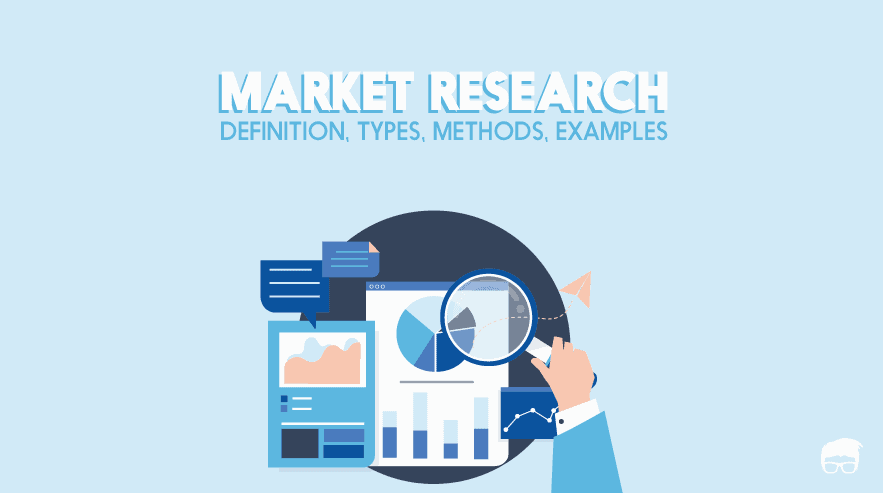Just having a strong gut feeling isn’t a very good reason to launch a product in the market without validating its demand, develop a marketing strategy without knowing the target audience, or just start a business when you don’t even know who your competitors are.
Accurate and thorough information is a prerequisite to a successful business venture because it helps the entrepreneur to determine the feasibility of his business before committing much to it.
Market research is what provides him with the relevant data to help him solve the challenges he’ll face during his business tenure.
What Is Market Research?
Market research is a systematic process of gathering, analyzing and interpreting data about the market to better understand the target group and to make more informed decisions about the company and its customers.
The result of market research is used to validate or invalidate hypotheses about the potential customers, their characteristics and habits, location and needs of the market, the competition, and the industry as a whole.
The Purpose Of Market Research
Market research forms the base to the business plan and the 4 Ps of marketing. Its primary purpose is to validate business hypotheses upon which successful strategies can be developed.
Why Is Market Research Important
In this era of cut-throat competition, having data to rely on is essential. Market research helps the business get the data to –
- Gain more insights about the customers and competitors – Market research helps the businesses to discover customer’s buying trends, habits, decision-making process, etc. It also provides them with the data of how the existing players are performing in the market.
- Reduce the risk of business/strategy failure – Accurate and up-to-date information about what drives the market helps the business to make more informed decisions and reduces the risk of failure.
- Forecast future trends – Market research is an important tool not only to know about the current trends but also to get data on what to expect in the future.
Market research is essential to get answers to questions like –
- Who the customer actually is?
- What factors affect his buying decisions?
- How well are the company’s products selling?
- What are the competitors doing in the market?
- What changes are currently happening in the market-place and what all can be expected?
The Types Of Market Research
Even though the definition of market research remains the same always, it can be classified into different types based on the goals, types of information required, and the way the information is collected.
Types Of Market Research Based On The Research Goals
- Exploratory: Exploratory research explores the nature of a problem. It is not intended to provide a final and conclusive solution to a problem but just to explore research questions. It usually includes open-ended questions and is used for exploring growth options, company’s present and prospective issues, etc.
- Descriptive: Descriptive research is used to describe the situations and is conclusive in nature. It is also called statistical research and is used to quantify data in situations like the market potential for a product, demographics of the target market, etc.
- Casual: Casual research is also structured and conclusive research used to explain the cause and effect relationship between variables. An example of casual research would be research to find out if the new package design increases the sales of a toy or not.
Types Of Market Research Based On The Type Of Information Required
- Qualitative: It is intended for exploratory research. That is, to explore and gain an in-depth understanding of how things work or how to solve a problem. The data collected in qualitative research is usually unstructured or semi-structured which is further used to set the hypotheses for further quantitative research.
- Quantitative: It’s statistical research which quantifies the data into variables which can be compared and evaluated. This quantified data helps in making definite decisions.
Types Of Market Research Based On The Way Information Is Collected
- Primary: Primary research is when the business collects the information itself or hires a third-party to do the same. It is designed to meet the unique and specific needs of the business concerned. It usually includes focus groups, questionnaires, surveys, interviews, and observations.
- Secondary: Any data taken from research or study that has already been done, analysed, and published by others comes under secondary research. This type of research involves obtaining data from studies done by government organisations, research companies, and other businesses of your industry.
Market Research Methods
Different types of research employ different methods of data collection. These market research methods can further be classified under two types –
Primary Research Methods
- Interview: One-on-one discussions to get qualitative and quantitative data over telephone, video conference, or face-to-face.
- Survey: Gathering information from a large number of people either face-to-face or through other methods using a standardized questionnaire. It can be used to collect both qualitative and quantitative data.
- Focus groups: It includes getting a bunch of people in a room and making them a part of a discussion which is pre-planned by the researcher and guided by a facilitator.
Secondary Research Methods
- Data available on the internet: Many internet companies and websites either conduct their own research or specialize in consolidating research data which is often available freely over the internet. Internet data from reliable sources is one of the most popular methods of secondary research.
- Data published by government and non-government agencies: Government agencies and non-government agencies conduct their own large-scale periodic research and make it publically available to be used by other organisations.
- Public libraries: Public libraries are full of information regarding the research conducted earlier which prove to be useful in comparing and evaluating current and past data.
- Commercial information sources: This includes sourcing data from commercial sources like newspapers, journals, magazines, radio and TV stations.
How To Do Market Research
Market research, especially primary research, is a long process, but it isn’t an uphill struggle. If planned well, it can result in productive data which gives good direction to the company’s business strategies. Here’s how you can conduct market research –
Define The Reason For The Research
You should always set a goal for market research.
What answers do you seek from the people? Is it just to explore the trends, buying habits, needs, wants, etc. or do you want concrete quantitative answers which describe a cause-effect relationship among some variables?
Identify the problem and develop a hypothesis to be validated by market research.
Identify The Sample Group
Once the problem has been identified, look for the sample group who is most likely to be affected by it and who is most likely to give the answers you need to validate your hypothesis.
Identifying the right sample group is a crucial step of the market research process as a wrong sample set will make the research and its data useless.
Identify The Most Suitable Research Type And Method
The selection of market research type and methods depend on many factors like –
- Is there any similar research conducted prior to this whose data is available for use?
- Is this research brand/company specific?
- What’s the nature of the research?
Prepare The Research Questions
If a primary research method is selected, the next step is to prepare a questionnaire. Having a standardized questionnaire makes it easy to collect data that can be analysed and compared.
Here’s a guide on how to make a questionnaire to help you with the same.
Conduct Research
This is probably the most time-consuming step in the primary market research process. It involves collecting data by conducting face-to-face surveys, telephonic interviews, online surveys, or other methods which were defined in the previous steps.
Summarize And Analyse The Findings
Once the data is collected, the next step includes summarizing it and analysing it to validate or invalidate the hypotheses made before the research was started.
Often, such data is also arranged in a presentable manner to prepare reports to be used by other people.
Go On, Tell Us What You Think!
Did we miss something? Come on! Tell us what you think about our article on market research in the comments section.
A startup consultant, digital marketer, traveller, and philomath. Aashish has worked with over 20 startups and successfully helped them ideate, raise money, and succeed. When not working, he can be found hiking, camping, and stargazing.









